
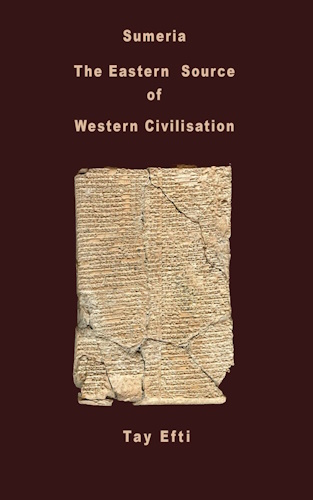

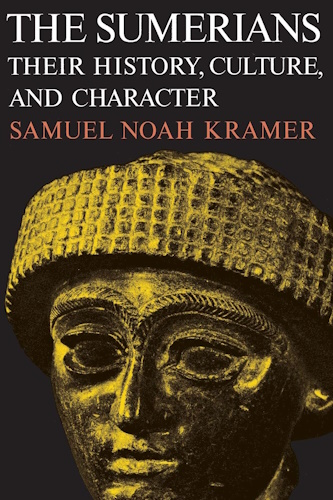

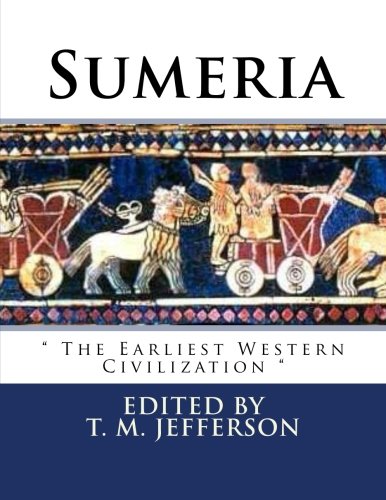



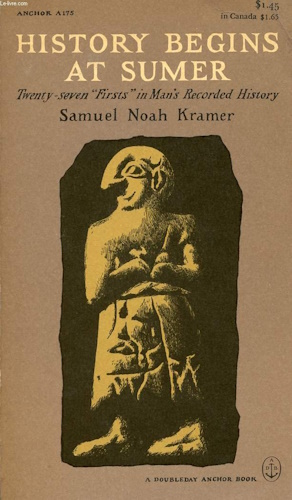

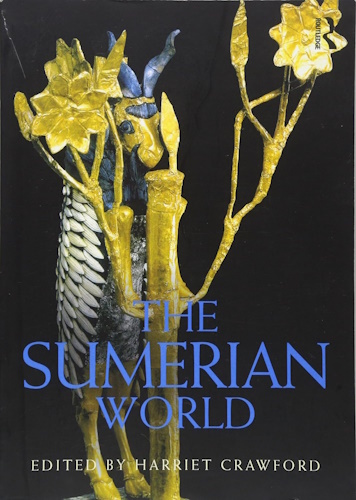

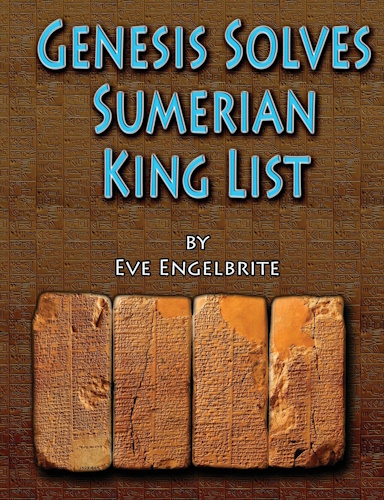

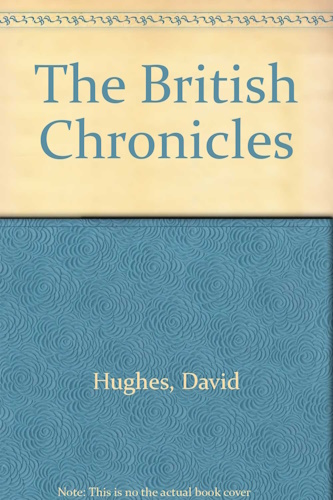
Ancient Sumeria
Nimrod's Story
by David Hughes
2005
Recovered from WayBackMachine
Ancient Sumeria
Nimrod's Story
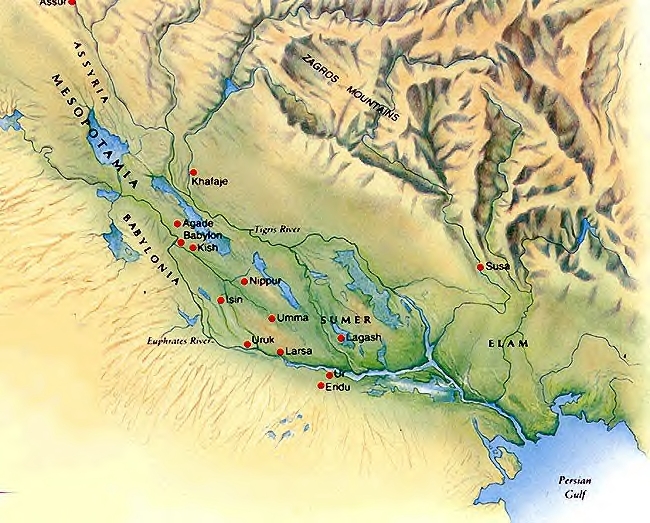
A. genealogy
1. Kush, the father of Nimrod, was the ancestor of the "Black African" race, the Kushites, according to the world's genealogy of seventy [or seventy-two] nations recorded by Moses in "The Table of Nations" (Genesis 10).
2. Mizraim, his brother, migrated to Egypt, called the "Land of Ham" in the Bible, and was the father of an eldest son and two younger twin sons. The eldest son, On, was the ancestor of Egypt's priests; and, the twins, Pathros and Caphtor, split Egypt between them and founded the double kingdoms of Upper and Lower Egypt, or "Dynasty 0." Later, Upper Egypt conquered Lower Egypt and drove out their cousins, the Caphtorites [who took ships and settled pre-Minoan Crete]; and, Mene[s], the son of Narmer "The Scorpion," the Viceroy of Upper Egypt in Nimrod's Sumerian Empire, and, his wife, Nimrod's sister, Quire, united Egypt as one nation. The kingdom of Lower Egypt, that is, of the Mizraimite-Caphtorites, was transferred from Lower Egypt to the Isle of Crete; and, transferred again from Crete to Troy [6th-7th Dyn.] at the time of the Minoan Conquest of Crete; and, from Troy, in North-West Turkey, after its epic fall fighting the Greeks and their allies [episode of "The Trojan Horse"], transferred again to Alba-Longa in Italy, which was the mother-city of Rome, whose emperors claimed the "world-throne" as Nimrod's successors. The British royal house also claimed to have been descended from the royal house of Alba-Longa in Italy. The ancestor, Brutus, a prince of the royal house of Alba-Longa, in Italy, during his exile in Greece, led a slave-rebellion of the Albanese [descendants of captive Trojans] in Greece, whom the Greeks had made their slaves, and resettled the colony in Britain, founding a kingdom and an Iron Age dynasty of kings among whose descendants are today's British Royal House.
3. Phut, the other brother, gave The Maghrib [North Africa, west of Egypt] a dynasty of kings; the ancient Kings of Libya.
B. early years
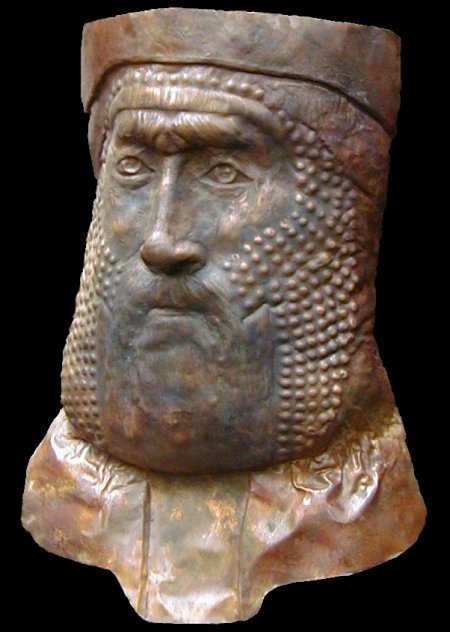
The Kushite prince Nimrod, called AEthiops in Greek Mythology, is said in ancient literature to have been a very charismatic young man who slew a dragon [a dinosaur], which deed made him popular among the people of the Mesopotamian settlement of the human-race. He was described in ancient literature as big and strong and a very handsome, athletic "black man," whose looks dazzled the eyes of his female admirers, and whose charisma spellbound his male followers.
C. conquests
The first post-diluvian attempt by the human-race to institutionalize a government was made by Nimrod at Babel, in Sumeria, Mesopotamia, where the main body of the human-race had set up camp. He overthrew the post-diluvian Semitic "patriarchate" [the Semite-line: which according to the "Noahic Covenant," was given a divine mandate to rule as a series of hereditary patriarchs], and establishing in its place an Hamitic "monarchy," as the world's first king as well as the first "world-king" since the entire human-race was re-unified by the monarchy or crown. Nimrod established a government at Babel over Sumeria; and extended his rule over other human settlements worldwide either by their consent or by force, and founded the world's first empire. He was the first person in world-history to make war on his own species, say all the ancient sources.
D. empire
Nimrod developed (1) a state, which was a monarchy, which was modeled after his understanding of Heaven‘s governmental-system to mirror it on earth, hence, it was a divine-monarchy, supposedly representing the kingdom of God on earth!; (2) a pagan religion, "zeroashtaism," based on his [and his successors'] identification with the "seed of the woman" of the "Edenic-Covenant" (Gen 3:15), with a priesthood and its schools, which supported the monarchy, whose royal ideology was the Sumerian religion, "zeroashtaism"; and (3) an economy, which commercial system has existed ever since. Nimrod attributed to himself divine honors claiming to be "the woman's seed" of God's prophecy to Adam and Eve, the "Edenic Covenant," (Gen. 3:15). Nimrod was the proto-type of the future "Anti-Christ" in the Bible; for it is "Christ," or "Messiah," to whom the prophecy of Genesis 3:15 applies. Nimrod invented money and introduced a monetary system and issued the first coinage. He introduced the calendar and the division of the day onto twenty-four hours. In fact, about everything we find in civilizations, weights, measurements, writing, etc., all began at Babel in Nimrod's empire.
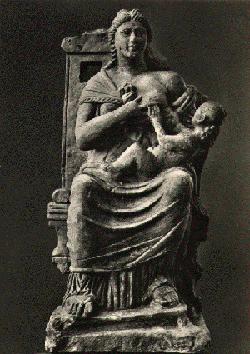
His wife, Semiramis, appears as an evil queen in ancient literature. He was her 2nd husband, for her first husband had been Puluku [Peleg], the Semitic Patriarch, who had served in Nimrod's empire as "viceroy of Syria." His son, Reu, grew up in the royal palace as an imperial prince. He was even considered "heir-expectant" of the throne until the birth of his half-brother, Bel, the first King of Babel or Babylon or Sumer, identified with Tammuz in Babylonian Mythology. Bel was the posthumous son of Nimrod and Queen Semiramis [his mother], who claimed him to be Nimrod-reborn, thus, still king, and sat him on the throne in order to maintain her position as queen-consort, and, at the same-time, the queen-mother. Nimrod's posthumous son, Bel, was identified as "the woman's seed" of Genesis 3:15, the "madonna and child" cult, which was the dynasty's royal ideology, which was actually the royal ideologies of all the ancient world's dynasties, since it gives a divine-mandate, and gave Babel a line of kings, who were interpreted as successive incarnations of "the woman's seed" in a dynasty of god-kings.
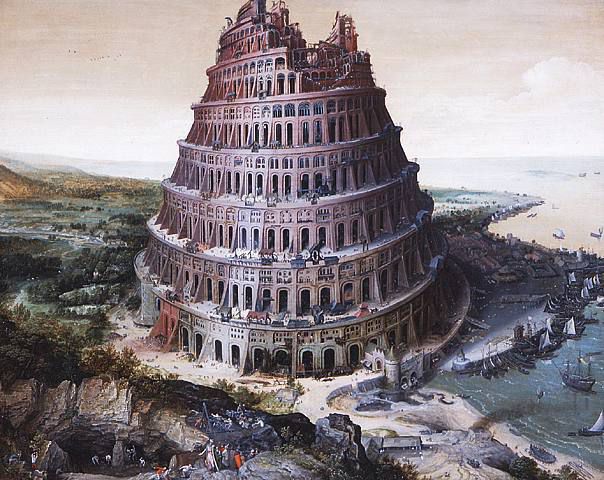
The Tower of Babel, the "confusion of tongues," & the "dispersion of the human-race"
E. rupture:
The construction of the "Tower of Babel" was begun by Nimrod but was temporarily halted at the time of the "confusion of tongues" which sparked the "dispersion of the human-race" all over the world. Nimrod was murdered during the chaos that followed the "confusion of tongues." His posthumous son, Bel, [with his mother, Queen Semiramis, as regent] succeeded his father in a much reduced empire, comprising only Mesopotamia [Sumeria]. He later completed the "Tower of Babel" project. There, at Babel, God "confused the tongues" of the human-race, and scattered the human-race throughout the world, encouraging the development of human government to develop in the human-race of nations.
It was at this time during the "great migrations" that Atlas and eight of his nine brothers, the sons of Iapet, the middle son of Noah, called "Titans" in Greek Mythology, migrated from Morocco [where Mestor and his tribe remained behind] to the islands of the Atlantic Ocean, among whom were Ampher[us] [the Welsh Albion "Gawr"], whose tribe settled in the British Isles with him as Britain's first king, the founder of the Bronze Age dynasty of "Sacral-Kings" of Britain and The Isles. These were the proto-Picts, who originally populated the British Isles.
Formation of nations & the rise of civilization
A. Babel: city-state
Bel, the posthumous son of Nimrod and Queen Semiramis, however, gathered together the remnants of the world-government-system and established the state of Babel or Sumer; and, Bel is reckoned as the first King of Babel, or Sumer, and the ancestor of its dynasty, the Belgae [Baltheride] [Baalite], whose successors were represented by branches of Bel's descendants as the kings of several Sumerian city-states. The royal house of the Phoenicians at Tyre, previously at Sidon, was Baalite. Bel completed the construction of the Tower of Babel, a ziggurat, the great-temple to their god [Satan], and completed the walls of Babylon, and completed most of the other projects begun by his father, such as the "united-nations" headquarters. He made Babel-Babylon into the world's most splendid city, to symbolize its supposed status as the world's capital-city. There was a rivalry between Bel, and his descendants, verses Reu, and his descendants. Kingdom of Babel flourished for hundreds if not perhaps a thousand years, circa 4500-3500BC, under Bel's descendants, and fell at the time of the conquest of Mesopotamia by the Semitic-Sumerians, under Reu's descendants, displacing most of its native population, the Hamitic-Sumerians ["Ubaidians"].
B. Salem: city-state
Reu, the heir of the Semitic patriarchate, has a descent-line unrecorded in the Bible. His descendants held sway at Salem, the site of the future Jerusalem. There is a large gap in the Bible genealogy between Reu and his "descendant," not "son," Serug. It appears that an ancient scribe thought the "Torah" needed a chronology, so he gave it one. The age-scale of the generations is the later chronology version of the text, whereas the text of just "begots" was the original manuscript written by Moses. Reu was a rival against his half-brother, Bel, for the world-throne, which essentially disappeared with the collapse of Nimrod's world-empire due to the chaos that took place at the dispersion of the human-race, however, the concept of a "world-throne" was still there.
C. Egypt: national-state
Meantime, Mene[s], the son of Nimrod's sister, Quire, and, her husband, Narmer "The Scorpion," the viceroy of Upper Egypt in Nimrod's empire, after Nimrod's death, claimed the world-throne, and, took up residence at Memphis, Egypt, where he established a state, a religion [an Egyptianized version of Sumerian "zeroashtaism"], and a culture, and, is reckoned as Egypt's first king. He was the ancestor of Egypt's 1st-Dynasty [9 kings].
D. Sumer: city-states
The successors of the Hamitic Sumerian kings of Babel, or Babylon, or Sumer, were the kings of Kish/Kush, the Sumerian city-state, whose dynasty is somewhere said to have been the first post-diluvian royal house [though Babel actually was], which is only a reference that Kush was onetime the dynasty's residence.
The Baalite Dynasty re-emerges as the first dynasty of the Sumerian city-state of Kish [Kush]. The Sumerian city-state of Kish/Kush, its first dynasty, the Baalite Dynasty, was founded by Gaur (Galar), called the "first" King of Kish/Kush, the son of King Zi-U-Sudra of Babel, or Sumer, who was considered to represent the old Babel government-in-exile at Kish/Kush as its 11th king, but in reality was actually the founder and the first king of the 1st-Dynasty of Kish/Kush. There were 23 kings in the 1st-Dynasty of Kish/Kush from King Gaur to King Agga, the last king of the 1st-Dynasty. The 1st-Dynasty of Kish obtained to empire under its king Etana, called "The Shepherd" [# 13 in list], about whom an epic survives. The heritage of Kish/Kush, whose kings were the heirs of the Kings of Babel and/or Sumer, who reigned as the emperors of the Sumerian Empire, was that of a "world-throne"; that is, until the time of the Akkadian Empire, their successors, which passed the heritage on to their "cultural descendants," the Babylonian emperors. The Sumerian emperors, the Babylonian emperors, and, the Romans emperors, in their turn, claimed worldwide dominion, sitting on the world-throne, and reigned as a dynasty of god-kings.
The defeat and death of King Agge of Kish/Kush in battle fighting Enkhegal, King of Lagash, who threw-off the domination of Kish, gave the royal heir Shulum [the son of the King of Awan] the opportunity to usurp the throne in Kish/Kush.
The kingdom of Lagash and its 1st [Semitic] Dynasty [11 kings] was founded at this time by Enkhegal, which dynasty of Lagash was contemporary with the 1st Dynasty of Ur [3 kings] and the 1st Dynasty of Erech [Uruk] [12 kings], both off-shoots of the 1st Dynasty of Kish [23 kings]; and, also, contemporary with the 2nd Dynasty of Kish [8 kings]. The grandson of King Enkhegal of Lagash, Ur-Nanshe of Lagash, thirty years later, conquered the Sumerian city-states of Elam, Mari, Ur, Uruk [Erech], Kish, Susa, Umma, Isin, Larsa, Nippur, Sippar, Eridu, Awan, Hamasi, Adab, Khati, Eshnunna, Khana, Aleppo, Elba, and others, which became his vassal-states, and reigned as Sumerian emperor, which then was understood to mean "world-king." He created an empire for Lagash in Sumeria, maintained by his descendants, until its conquest by Erech.
Meantime, the twin sons of King Agga of Kish, Mes-agga-sheri and Mes-anne-paddi, the Kushite co-heirs, both established themselves as kings of other Sumerian city-states: Mes-agga-sheri was the first King of Erech [Uruk], the founder of its first dynasty [12 kings]; and, Mes-anne-paddi was the first King of Ur, the founder of its first dynasty [3 kings].

Erech rose to empire, under its king, Utukhegal [# 7 in list], with the decline of Lagash, another Sumerian city-state, which submitted to its vassalage, and reigned as a Sumerian emperor. Another famous king of Erech was Gilgamesh [# 5 in list], whose epic survives of how he went to visit his ancestor, Uta-Napishtim, the Sumerian name for the English name Noah, identified with the Noah of the Bible, who was still alive, and, who, according to mythology, in his old age went to reside on a large island in the sea with his grandson Atlas, the 1st King of Atlantis [the legendary "lost continent," whose mountain-peaks are today the Azore Islands], to whom he tells the story of "The Flood," which is the Sumerian account of the Biblical account of "Noah's Flood." King Enetarzi [En-entar-zi] of Lagash [formerly a priest, a younger son of King Enannatum II] lost the empire to King Lugal-Ke of Erech, who restored the empire of Erech.
The 2nd Dynasty of Kish [8 kings] was founded by Shalom (above), whose father, grandfather, and great-grandfather, were the three successive kings of Awan, another Sumerian city-state, whose dynasty [3 kings], representatives the Semitic Reuite-Line, reigned supreme in Sumeria for three generations, whose kings were descendants of Reu, the Sumerian imperial prince, whose descent-line, with gaps, is recorded in the Bible. The names of the three kings of the short-lived kingdom of Awan are unknown.
It was during this period that the 2nd-Dynasty of Ur [4 kings] was founded by Alla, whose descendant, Kaku, was overthrown by King Lugal-ane-mundu of Adab, its only king. He reigned for a time as Sumerian emperor, and suppressed a rebellion of Elam, a Sumerian city-state. He was succeeded as Sumerian emperor by King Anpu of Mari, who founded its 1st dynasty [6 kings]. His descendant, Iblul, the last king of the 1st-Dynasty of Mari, was slain by King Ar-Ennum of Ebla, who placed his son, Ibbi-Sipish, as King of Mari [2nd-Dynasty], and was succeeded himself in Elba by his eldest son, Ebrium. The son of King Iblul of Mari, Unzi, founded the Dynasty of Akshak [6 kings]. He overthrew Queen Kubaba of Kish.
Queen Kubaba of Kish [3rd-Dyn.], widow of the late King Lugal-mu of Kish [2nd Dyn.], her husband, seized the throne on her husband's death and reigned in Kish as the only monarch of the 3rd-Dynasty of Kish [1 ruler]. She was the daughter of King Hadanish of Hamazi, who earlier reigned as Sumerian emperor. His death and the conquest of Hamazi left its royal family dispossessed and destitute; and, the young princess for a while was a tavern-keeper until her discovery and marriage to then Prince Lugal-mu of Kish. She led an energetic campaign to liberate Kish from Erech's domination, and ends up actually taking the city-state, Erech. She deposed King Lugal-Ke of Erech and took his family hostage, that is, she dispossessed the 1st-Dynasty of Erech [12 kings], and placed her son, En-uk-du-anni, on the throne of Erech [2nd-Dyn.: 3 kings], whose son, Lugalure, maintained the kingdom, but, his son, Argandea, was overthrown by Lugalzaggisi, the King of Umma, another Sumerian city-state, who, usurped the throne, and founded the 3rd-Dynasty of Erech [1 king]. His military-conquests revived the empire of Erech. He conquered 1st-Dynasty Lagash, whose last king, Urukagina, watched the city destroyed by the enemy. Lugalzaggisi rose to reign as Sumerian emperor. He was later overthrown by Sargon of Agade.

Sargon of Agade was the grandson of King Lugal-Ke of Erech [1st-Dyn.]. His mother, Azupirana, is called a high-priestess, which means that she may have been his father's concubine, not wife. She put the babe Sargon in a small basket found by Queen Kubala of Kish [3rd-Dyn.], who conquered Erech and numerous other Sumerian city-states. She appears to have raised Sargon and adopted him, unaware of the child's parentage.
The truth of the parentage of Sargon was revealed that he was the son of the hostage Kishite prince Agga, the son of King Lugal-Ke of Erech, whom Queen Kubaba overthrew, and took Prince Agga hostage, whom she made her gardener, who, by a high-priestess, Azupirana, begot Sargon. It was fear for Sargon's life that led his mother, Azupirana, to conceal his existence; and, he grew up as the foster-son of Queen Kubala of Kish, unaware he was the very child she sought to slay, as the heir of the old royal house.
King Unzi of Akshak overthrew Queen Kubala. He permitted the succession of her son, Pzu-Zin (Puzursin), who founds the 4th-Dynasty of Kish [7 kings]. His brother, Ur-Za-Baba (Urzababa), King of Kish, was overthrown by his cup-bearer, Sargon. It was the general custom at this time to have a hostage-prince of another country as the "cup-bearers" in foreign courts. Sargon (Sharrum-kin) deposed King Ur-Za-Baba of Kish [4th-Dyn.], usurped and/or restored the male-line of the 1st-Dynasty of Kish [through 1st-Dynasty Erech] on the throne as the 5th-Dynasty of Kish/Kush, and, went on to conquer all the Sumerian city-states, and revived the Sumerian empire, uniting it federally by simply establishing a new capital-city at Agade, rather than at Kish. Hence, the 5th-Dynasty of Kish became the Dynasty of Agade [11 emperors]. Still, in Kish, the brother of Ur-Za-Baba, namely, Zimu-dar, reigned as Sargon's vassal-king; and was succeeded by his son, Usi-watar, reckoned as a continuation of Kish's 4th-Dynasty, who were vassals to the Akkadian emperors.
E. Agade: empire

Victory Stele in the Louvre
The military-exploits of Sargon's descendants, especially those of King Naram-Sin of Agade, extended the Akkadian Empire beyond Mesopotamia into the Middle-East, Iran [Elam], South-East Europe, and whose army marched the entire length of North Africa, and, according to myth expelled the Atlanteans, the "giants" mentioned in the Bible [many of whose remains have been dug up], who can be verified to have actually existed in the early history of the human-race. The Akkadian Empire declined in power during the reigns of its later kings, and eventually was conquered by Indo-Europeans, the Gutians [ancestors of the Getae of Thrace, the Jutae of Denmark, and the Geats of Scandinavia], who, occupied Mesopotamia for about a hundred years. Prince Ur-Nigin of Agade [the son of its last king, Shudural] founded the 4th-Dynasty of Erech [5 kings], which emerged as a vassal-state during the occupation of Mespotamia by the Gutian kings, and flourished during the Gutian occupation, and kept the native Sumerian culture alive. Three Gutian kings [one list gives 21 kings] reigned over the Gutian Empire, about 100 years, until the Gutians were driven out of Mespotamia by Utu-Khegal (Utuhegal) [son of Ur-Babbar, last king of 4th-Dynasty Erech], and founds the 5th-Dynasty of Erech [1 king], and restores Sumerian civilization.
It was during the confused political situation in Sumeria following the expulsion of the Gutians that the Sumerian prince Serug, "descendant" of Reu (above), representative of "the Reuite-Line," who had been appointed governor of Ur by the Gutians, even though he was a native Sumerian from Lagash, secured his position and declared himself King of Ur, founding its 3rd-Dynasty. Mesopotamia experienced its last renaissance of Sumerian culture during the period of the 3rd-Dynasty of Ur. The kings of 3rd-Dynasty Ur [10 kings], held sway over the whole of Mesopotamia and ruled as Sumerian emperors for about a hundred years.
The brothers of Serug were King Ur-Baba of Lagash [founder of its 2nd-Dynasty], and, his successor, King Gudea of Lagash. [Ur-Baba was survived by two daughters, one married her uncle, Gudea, and was the mother of Ur-Ningirsh, the father of Ugme; and the other daughter married Urgar, a Semitic prince, and was the mother of Nammakhni, [last] King of Lagash [2nd-Dyn.], who was overthrown by his kinsman Ur-Nammu, King of Ur, the son of Serug. The two sons of Serug were Ur-Nammu and Ur-Nahor [I].
Serug, acknowledged his vassalage to Erech‘s empire, but, his son, Ur-Nammu, the dynasty's most illustrious king, broke free of Erech‘s domination, and, by his military-campaigns gave Ur its great empire. He overthrew King Utu-Khegal of Erech, and all the Sumerian city-states became his vassals, either by acknowledgement or by force.
His son, Ur-Engur, succeeded Ur-Nammu in the empire. Ur-Engur died childless, and the throne passed to his uncle, Ur-Nahor [I]. Ur-Nahor [I] was the father of three sons: Sulgi, Dungi, and Turgi. Turgi is identified with Terah in the Bible, the father of Abram [Abraham], of whom later. Ur-Nahor [I] was succeeded by his son, Sulgi. Sulgi, was murdered by his brother Dungi, who usurped the throne in prejudice of his late brother's eldest son, Bur-Sin, who overthrew his uncle, and took the throne. Bur-Sin, was succeeded in turn by his two brothers, Ama-Sin and Shu-Sin, after which their cousin, Gimil, the son of Dungi, their late uncle, usurped the throne in prejudice of the son of the late king Shu-Sin, namely, Ibi-Sin. Later, upon Gimil‘s death, Ibi-Sin, the rightful heir, took the throne. He was the last king of 3rd-Dynasty Ur, whose idol-worship decayed the empire; which was conquered by Elam [1st Persian dynasty], another Sumerian city-state.
The news of the defeat and death of King Ibi-Sin of Ur in battle versus King ..... of Elam [the father of Chedorlaomer, the King of Elam, who conducted a campaign in Palestine during Abraham's time there] sent the royal house of Ur in flight along with thousands of refugees many hundreds of miles to the north out of harm's way and took up residence at Haran [so-called by Prince Turgi/Terah in memory of his late middle son]. This historical episode is called the "Call of Abram" in the Bible, when God called Abram out of Ur, however, the Bible account omits many details. His father Terah [Turgi] remained a heathen who worship the pagan moon-god Allah, however, Abram "crossed-over" to the worship of Yahweh [anglicized as "Jehovah"], the "The One True God," with whom he made a covenant.
Elam dominated Persia while the city-states of Isin, Larsa, and Mari, dominated Sumeria. Later, we find Assur, Babylon, and Larsa compete for dominance in Mesopotamia; during the increasing influence of the Elamite Empire, as well as Egypt [11th-Dynasty], and the Hittite Empire. Assur was the first capital city of the Assyrians, whose first king is reckoned to have been Tudija, a Semitic prince. Babylon [city-state of which Babel was a precinct] rose to empire under its 1st Dynasty, which was founded by Sumuabi, an Akkadian [Baalite] prince. Larsa, under its 12th king, Rimsin, conquered Isin and re-united Southern Mesopotamia, and reigned as a Sumerian emperor. Larsa was conquered by the "first" Babylonian Empire, under Hammurabi, 1st-Dynasty of Babylon[ia], which inherited "the Sumerian heritage."
![]()
![]()
Disclaimer:
Some material presented will contain links, quotes, ideologies, etc., the contents of which should be understood to first, in their whole, reflect the views or opinions of their editors, and second, are used in my personal research as "fair use" sources only, and not espousement one way or the other. Researching for 'truth' leads one all over the place...a piece here, a piece there. As a researcher, I hunt, gather and disassemble resources, trying to put all the pieces into a coherent and logical whole. I encourage you to do the same. And please remember, these pages are only my effort to collect all the pieces I can find and see if they properly fit into the 'reality aggregate'.
Personal Position:
I've come to realize that 'truth' boils down to what we 'believe' the facts we've gathered point to. We only 'know' what we've 'experienced' firsthand. Everything else - what we read, what we watch, what we hear - is what someone else's gathered facts point to and 'they' 'believe' is 'truth', so that 'truth' seems to change in direct proportion to newly gathered facts divided by applied plausibility. Though I believe there is 'truth', until someone representing the celestial realm visibly appears and presents the heavenly records of Facts And Lies In The Order They Happened, I can't know for sure exactly what "the whole truth' on any given subject is, and what applies to me applies to everyone. Until then I'll continue to ask, "what does The Urantia Book say on the subject?"
~Gail Bird Allen
![]()
![]()














-
Urantia Book, 44:0.11 - The Celestial Artisans
Never in your long ascendancy will you lose the power to recognize your associates of former existences. Always, as you ascend inward in the scale of life, will you retain the ability to recognize and fraternize with the fellow beings of your previous and lower levels of experience. Each new translation or resurrection will add one more group of spirit beings to your vision range without in the least depriving you of the ability to recognize your friends and fellows of former estates.
-
Princess Bride 1987 Wallace Shawn (Vizzini) and Mandy Patinkin (Inigo Montoya)
Vizzini: HE DIDN'T FALL? INCONCEIVABLE.
Inigo Montoya: You keep using that word. I do not think it means what you think it means. -
Urantia Book, 117:4.14 - The Finite God
And here is mystery: The more closely man approaches God through love, the greater the reality -- actuality -- of that man. The more man withdraws from God, the more nearly he approaches nonreality -- cessation of existence. When man consecrates his will to the doing of the Father's will, when man gives God all that he has, then does God make that man more than he is.
-
Urantia Book, 167:7.4 - The Talk About Angels
"And do you not remember that I said to you once before that, if you had your spiritual eyes anointed, you would then see the heavens opened and behold the angels of God ascending and descending? It is by the ministry of the angels that one world may be kept in touch with other worlds, for have I not repeatedly told you that I have other sheep not of this fold?"
-
Urantia Book, Foreword - 0:12.12 - The Trinities
But we know that there dwells within the human mind a fragment of God, and that there sojourns with the human soul the Spirit of Truth; and we further know that these spirit forces conspire to enable material man to grasp the reality of spiritual values and to comprehend the philosophy of universe meanings. But even more certainly we know that these spirits of the Divine Presence are able to assist man in the spiritual appropriation of all truth contributory to the enhancement of the ever-progressing reality of personal religious experience—God-consciousness.
-
Urantia Book, 1:4.3 - The Mystery Of God
When you are through down here, when your course has been run in temporary form on earth, when your trial trip in the flesh is finished, when the dust that composes the mortal tabernacle "returns to the earth whence it came"; then, it is revealed, the indwelling "Spirit shall return to God who gave it." There sojourns within each moral being of this planet a fragment of God, a part and parcel of divinity. It is not yet yours by right of possession, but it is designedly intended to be one with you if you survive the mortal existence.
-
Urantia Book, 1:4.1 - The Mystery Of God
And the greatest of all the unfathomable mysteries of God is the phenomenon of the divine indwelling of mortal minds. The manner in which the Universal Father sojourns with the creatures of time is the most profound of all universe mysteries; the divine presence in the mind of man is the mystery of mysteries.
-
Urantia Book, 1:4.6 - The Mystery Of God
To every spirit being and to every mortal creature in every sphere and on every world of the universe of universes, the Universal Father reveals all of his gracious and divine self that can be discerned or comprehended by such spirit beings and by such mortal creatures. God is no respecter of persons, either spiritual or material. The divine presence which any child of the universe enjoys at any given moment is limited only by the capacity of such a creature to receive and to discern the spirit actualities of the supermaterial world.
-
Urantia Book, 11:0.1 - The Eternal Isle Of Paradise
Paradise is the eternal center of the universe of universes and the abiding place of the Universal Father, the Eternal Son, the Infinite Spirit, and their divine co-ordinates and associates. This central Isle is the most gigantic organized body of cosmic reality in all the master universe. Paradise is a material sphere as well as a spiritual abode. All of the intelligent creation of the Universal Father is domiciled on material abodes; hence must the absolute controlling center also be material, literal. And again it should be reiterated that spirit things and spiritual beings are real.
-
Urantia Book, 50:6.4 - Planetary Culture
Culture presupposes quality of mind; culture cannot be enhanced unless mind is elevated. Superior intellect will seek a noble culture and find some way to attain such a goal. Inferior minds will spurn the highest culture even when presented to them ready-made.
-
Urantia Book, 54:1.6 - True And False Liberty
True liberty is the associate of genuine self-respect; false liberty is the consort of self-admiration. True liberty is the fruit of self-control; false liberty, the assumption of self-assertion. Self-control leads to altruistic service; self-admiration tends towards the exploitation of others for the selfish aggrandizement of such a mistaken individual as is willing to sacrifice righteous attainment for the sake of possessing unjust power over his fellow beings.
-
Urantia Book, 54:1.9 - True And False Liberty
How dare the self-willed creature encroach upon the rights of his fellows in the name of personal liberty when the Supreme Rulers of the universe stand back in merciful respect for these prerogatives of will and potentials of personality! No being, in the exercise of his supposed personal liberty, has a right to deprive any other being of those privileges of existence conferred by the Creators and duly respected by all their loyal associates, subordinates, and subjects.
-
Urantia Book, 54:1.8 - True And False Liberty
There is no error greater than that species of self-deception which leads intelligent beings to crave the exercise of power over other beings for the purpose of depriving these persons of their natural liberties. The golden rule of human fairness cries out against all such fraud, unfairness, selfishness, and unrighteousness.




